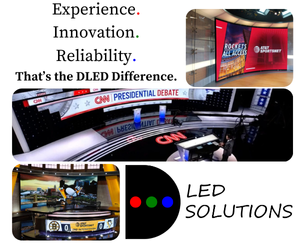A shift in video consumption habits calls for a hybrid video solutions strategy

Subscribe to NCS for the latest news, project case studies and product announcements in broadcast technology, creative design and engineering delivered to your inbox.
Video consumption models are evolving. Over the last few years, consumer demand for subscription video on demand (SVOD) services has been rising steadily. Statistica reports that SVOD revenues will reach nearly $26 billion in 2020, growing at an annual rate of 4.1%. People aren’t just watching OTT video in the United States. It’s a global trend. More than 310 million connected households will have at least one OTT service by 2024, according to Parks Associates.
How does the rise of OTT affect linear TV? Over the last few years, industry stakeholders have questioned whether on-demand video consumption and linear TV can coexist. Having worked on both sides of the industry, I believe that they can and will for the years to come. Linear TV is not going to disappear. Live video such as sports events, news, interactive shows and primetime content is a key reason why many subscribers keep their pay-TV services while also subscribing to OTT offerings. According to MoffettNathanson research, 53% of U.S. households consume sports on a regular basis (daily, weekly, or monthly) and, of those, 90% continue to subscribe to pay-TV. In addition, another influencing aspect is the “lean back and consume” attitude of viewers. After a hard day’s work, many just want to turn on their devices and be presented with the interesting content that is out there. These factors combined with recommendations from friends and family on the latest series will continue to be the driving force of linear TV consumption.
Complementary Nature of OTT and Pay-TV
For consumers like you and me, this is an exciting era. Today, we have many ways to choose how and what we want to watch. There are hundreds of hours of content available and a variety of different screens suitable for video consumption, including smartphones, tablets, PCs and TVs. We are in the luxurious position where we can choose between standard definition (SD), high definition (HD) and even Ultra HD (UHD) content, and between multiple devices for easy access content.
For broadcasters, pay-TV operators, and content owners the current TV environment represents both a challenge and an opportunity. These industry players have some important decisions to make as they navigate this ever-evolving landscape and look to uncover new ways to reach, engage and retain fragmented audiences.
Ultimately, to stay competitive, broadcasters and media companies need to up the viewing experience and ensure simplicity for consumers to access content. And how do they do that? By embracing hybrid content distribution and providing both linear TV and OTT content so that consumers can enjoy the best of both worlds easily. According to the Leichtman Research Group, more than half of U.S. households have both a pay-TV and SVOD subscription, and this has been rising steadily. ABI Research analysts predict that given the rate at which the pay-TV industry is introducing OTT as an additional and complementary service, traditional pay-TV offerings will eventually become indistinguishable from a pure OTT package of services.
Hybrid Video Distribution in Action
An increasing number of big media companies broadcasting linear content are transforming their offerings by launching OTT platforms. It’s a way to make sure they are providing the best consumer experience and reaching all possible target audiences within a household. A great example is the soon-to-be-launched Peacock service from NBCUniversal, a division of Comcast. The Peacock service will feature over 15,000 hours of video, including live and on-demand content.
Another example is Sky, which launched its Sky Multiscreen service to reach viewers on any screen. This service gives viewers the flexibility of choosing where and when they want to watch linear or downloadable content via additional TV screens, mobile devices and tablets.
Benefits of multiscreen distribution companies such as NBCUniversal and Sky see the benefits of a multi-platform, multiscreen content approach, with a key advantage being building brand loyalty. Consumers today are looking for convenience. They want to be able to access a wide range of different TV offerings from any device they want. Content providers need to make sure their service is available to keep viewers satisfied.
Delivering multi-platform, multiscreen content is also a great way to optimize the TV experience. Audiences are using second screens to deepen their understanding about the content they are watching on TV and creating a social buzz. According to data from Nielsen, 88% of U.S. viewers use a second digital device while watching TV. Seventy-one percent of Americans look up content related to the content they are watching, and 41% are messaging friends and family about the content they are watching. Content providers can offer viewers complementary content on the second screen that correlates with what their audiences are watching on the main TV—for instance, live sports statistics during a major soccer match.
Making content available on multi-devices also represents an opportunity to collect and analyze video consumption habits. Using the data that has been collected, content providers can adjust their content and ad strategy to ensure it is relevant for viewers. Even better: this data can be used for dynamic ad insertion, opening up new revenue opportunities.
Finally, having a hybrid content distribution approach is essential for reaching diverse audiences. Cable operators can currently leverage the wide technical reach of satellites to provide TV in certain areas of the world where broadband infrastructure is limited. However, introducing additional OTT services can attract viewers that are looking for multiscreen and flexible experiences. For OTT players, utilizing satellite capabilities gives them an instant reach to millions of TV households and the ability to deliver content in exceptionally high quality.
Conclusion
However, content management and distribution can be complex. Broadcasters and media companies have more steps to overcome as they manage and deliver content in a multifaceted way, both for linear TV broadcast as well as non-linear TV on a growing number of devices.
Some broadcasters, content providers and pay-TV operators have an in-house team to manage hybrid content distribution. Others lack the specific expertise and resources required to handle multi-platform, multiscreen distribution. They need an end-to-end hybrid video solution to streamline the management and delivery of video content, as well as provide intelligent processing based on individual platform requirements.
Through an end-to-end hybrid video solution, content providers can create seamless and reliable viewing experiences and better retain audiences. Hybrid video solutions can also help to reduce costs compared with the traditional approach of maintaining separate distribution processes, which is expensive and operationally inefficient.
It’s not a one-size-fits-all solution, as every content provider has a different setup and requirements. While SES provides end-to-end video services and solutions, the consultative role we play gives us an edge in being able to understand and advise. In some cases, simplifying multi-platform and multiscreen video distribution enables us to help our customers create more compelling video content offerings, build brand loyalty and drive new ROI. For other customers, the reliable bandwidth and the vast technical reach of our satellites does the trick. At the end of the day, the most important thing is that we ensure viewer happiness and help deliver exciting content worldwide.
Photo courtesy of Eric Audras/ONOKY/Getty Images.
Subscribe to NCS for the latest news, project case studies and product announcements in broadcast technology, creative design and engineering delivered to your inbox.




tags
Content Distribution, Content Segmentation, distribution, Licensing & Distribution, NBCUniversal, OTT, OTT Platform, peacock, SES, Sky Multiscreen, Subscription Video on Demand, video streaming
categories
Broadcast Industry News, Content, Content Delivery and Storage, Featured, Thought Leadership, Voices